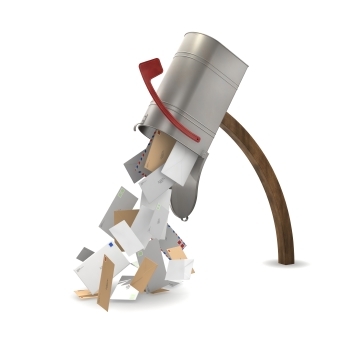
I walked to the mailbox the other day and gathered in about 14 pieces of mail. As I sorted through the mail, I retrieved the one bill that I was looking for and gently pitched the other 13 pieces of mail in the trash after I had roughly sorted through them. What a waste I thought. One of the letters had a check for $1000 in it. Needless to say, it was not quite real as it represented a $1000 off my new hearing aids. Fortunately, I do not need a hearing aid at this stage in my life but I wondered why I had received an offer like this. I suspect that I was part of a mass mailing to every homeowner in my ZIP code. Statistics show that 44% of all junk mail is discarded unopened. Again, all this paper, what a waste.
The United States Postal Service is facing a $238 billion dollar deficit in next decade and yet the Postal Service is the biggest deliverer of junk mail. The regular volume of first class letters has dropped 7% since 2001, an average of 1.3 billion fewer letters, postcards and bills each year. A 15% increase in bulk advertising and other discounted mailings has offset only some of this loss in revenue.
Advertising mail, also known as direct mail, junk mail or admail is the delivery of advertising material to recipients of postal mail. What is frustrating is that the Postal Service has enacted lower rates for buyers of bulk mail permits. In order to qualify for these rates, marketers must format and sort their mail in specific ways which reduces the handling required by the Postal Service. In the United States, “advertising mail” comprised over 43% of the total mail volume in 2003 and has been rising!
Advertisers often refine direct mail practices into “targeted mailing,” in which mail is sent out following database analysis to select recipients considered most likely to respond positively. For example a person who has demonstrated an interest in golf may receive direct mail for golf related products or perhaps for goods and services that are appropriate for golfers. This “database analysis” bothers me especially when I keep receiving notices from firms that I do business with or ordered products from that say “we do not sell the information from our customer database!” I wonder why then that I keep getting mail from all types of firms that I have never had any association with? How did they find out about me? How did they get my address?
In the United States, the Environmental Protection Agency estimates that the 44% of junk mail that is discarded unopened and unread equals four million tons of waste paper per year with only a small portion of this volume recovered for recycling. Each American consumer receives approximately 41 pounds of advertising mail annually. The Ohio Office of Compliance Assistance and Pollution Prevention Agency has estimated that 250,000 homes could be heated from a single day’s junk mail.
Waste management in the United States is in a state of anarchy with no effective federal plan in place to maximize recycling and minimize waste. America generates more waste each year, growing from 247 million tons of non-hazardous waste in 1990 to 409 million tons in 2001 according to an industry publication. It is estimated that paper or paper products comprise over 32% of this disposable waste.
It may be time to “opt out.” In the United States, there are several nonprofit organizations as well as many private sector alternatives that can be contacted. In response to a U. S. Supreme Court ruling (Rowan v. Post Office) the United States Postal Service enables an applicant to obtain a Prohibitory Order, which gives people the power to stop non-governmental organizations from sending them mail, and to demand such organizations remove the consumers’ information from their mailing lists.








